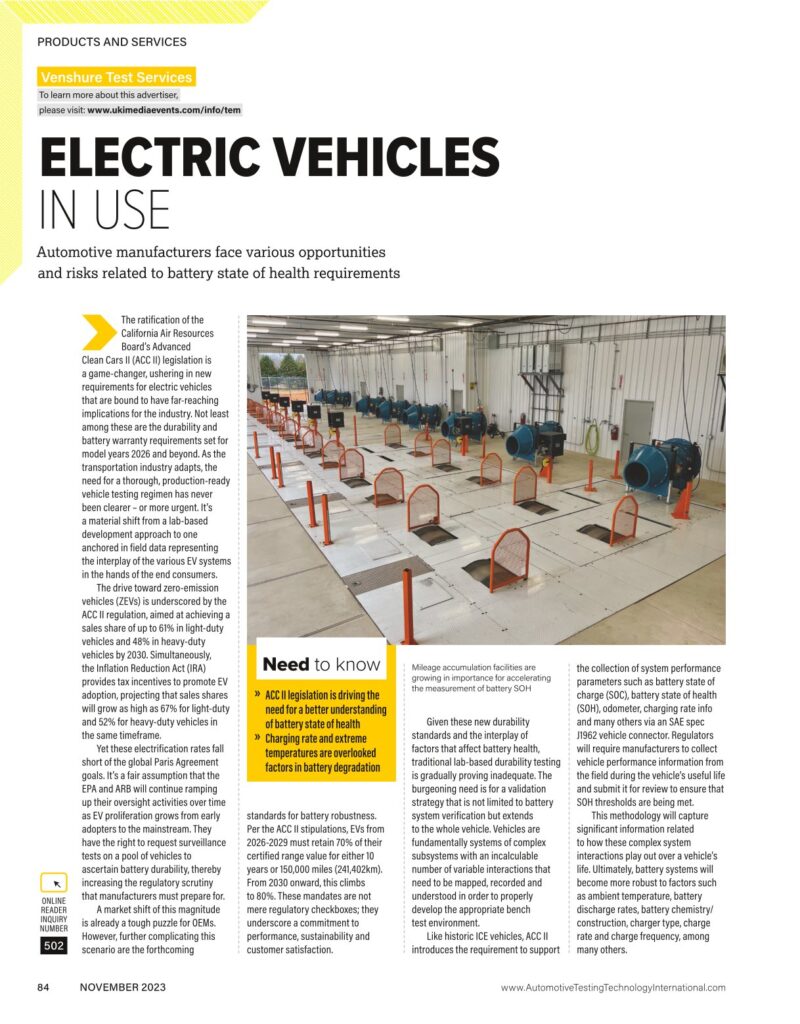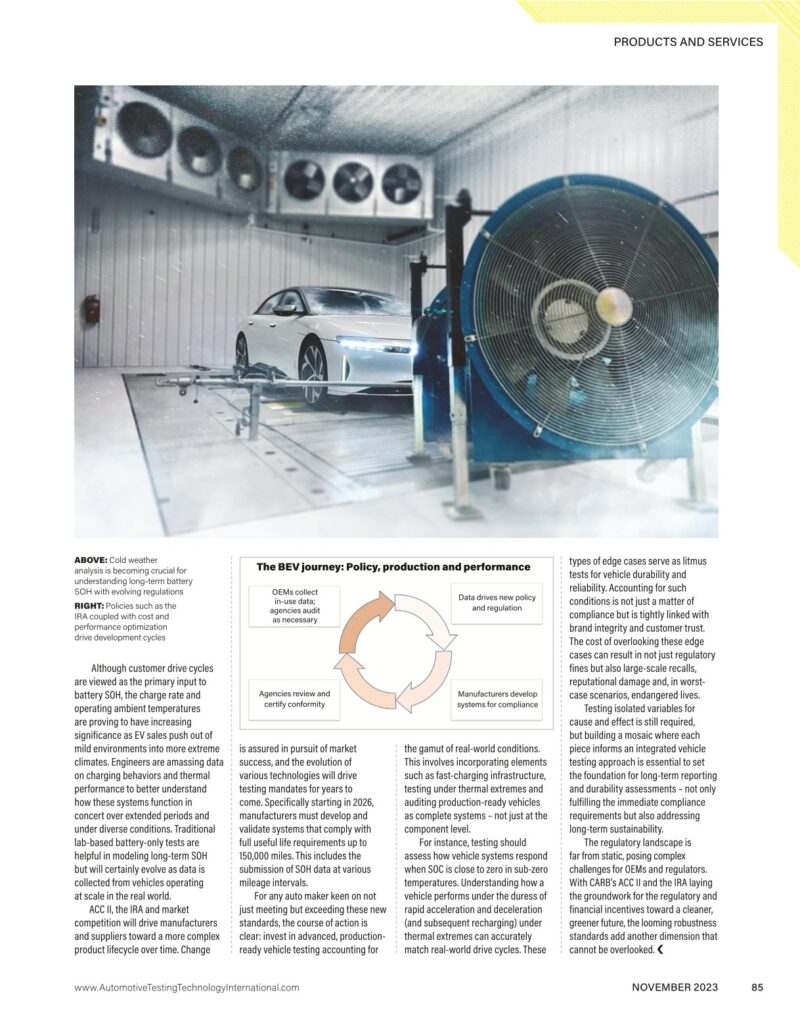

Electric Vehicles In-Use
Automotive manufacturers face various opportunities and risks related to battery state of health requirements.
NOVEMBER 2023. Originally published in Automotive Testing Technology International
The ratification of the California Air Resource Board’s Advanced Clean Cars II (ACC II) legislation is a game-changer, ushering in new requirements for Electric Vehicles (EVs) that are bound to have far-reaching implications for Industry. Not least among these are the Durability and Battery Warranty requirements set for model years 2026+. As the Transportation Industry adapts, the mandate for a thorough, production-ready vehicle testing regimen has never been clearer—or more urgent. It’s a material shift from a lab-based development approach to one anchored in field data representing the interplay of the various EV systems in the hands of the end consumers.
The drive toward Zero-Emission Vehicles (ZEVs) is underscored by California Air Resources Board’s Advanced Clean Cars II (ACC II) regulations, aimed at achieving a sales share of up to 61% in light-duty vehicles and 48% in heavy-duty vehicles by 2030. Simultaneously, the Inflation Reduction Act (IRA) provides tax incentives to promote EV adoption, projecting sales shares to ascend to as high as 67% for light-duty and 52% for heavy-duty vehicles in the same time frame. Yet, these electrification rates fall short of the global Paris Agreement goals. It’s a fair assumption that the EPA and ARB will continue ramping up their oversight activities over time as EV proliferation grows from “early adopters” to mainstream. They have the right to request surveillance tests on a pool of vehicles to ascertain battery durability, thereby increasing the regulatory scrutiny manufacturers must prepare for.
While a market shift of this magnitude is already a tough puzzle to be solved for OEMs, further complicating this scenario are the forthcoming standards for battery robustness. Per the ACC II stipulations, EVs from 2026–2029 must retain 70% of their certified range value for either 10 years or 150,000 miles. From 2030 onward, this climbs to 80%. These mandates are not mere regulatory checkboxes; they underscore a joint commitment to performance, sustainability, and customer satisfaction.
Given these new durability standards and the interplay of factors that affect battery health, traditional lab-based durability testing is gradually proving inadequate. The burgeoning need is for a validation strategy that is not limited to battery system verification but extends to the whole vehicle. Vehicles are fundamentally systems of complex subsystems with an incalculable number of variable interactions that need to be mapped, recorded and understood in order to properly develop the appropriate bench test environment.
Like historic Internal Combustion Vehicle (ICE) vehicles, ACC II introduces the requirement to support collection of system performance parameters such as battery State of Charge (SOC), battery State of Health (SOH), odometer, charging rate info and many others via an SAE spec J1962 vehicle connector. Regulators will require Manufacturer collection of vehicle performance information from the field during the vehicles Useful Life and submit it for review to ensure that SOH thresholds are being achieved. This methodology will capture “significant learnings” related to how these complex system interactions play out over a vehicle’s life. Ultimately battery systems will become more robust to factors like ambient temperature, battery discharge rates, battery chemistry / construction, charger type, charge rate, and charge frequency amongst many others.
While customer drive cycles are viewed as the primary input to battery SOH, the charge rate and operating ambient temperatures are proving to have increasing significance as EV sales push out of mild environments into more extreme climates. Engineers are amassing data on charging behaviors and thermal performance to better understand how these systems function in concert over extended periods and under diverse conditions. Traditional lab-based battery-only tests are helpful modeling long term SOH, but will certainly evolve as data is collected from vehicles operating at scale in the real world.
ACC II, the IRA and market competition will drive Manufacturers and Suppliers toward a more complex product lifecycle over time. Change is assured in pursuit of market success and the evolution of various technologies will drive testing mandates for years to come. Specifically starting in 2026, manufacturers must develop and validate systems that comply with full useful life requirements up to 150k miles. This includes the submission of SOH data at various mileage intervals.
For any automaker keen on not just meeting but exceeding these new standards, the course of action is clear: Invest in advanced, production-ready vehicle testing accounting for the gamut of real-world conditions. This involves incorporating elements such as fast charging infrastructure, testing under thermal extremes, and auditing production ready vehicles as complete system – not just at the component level.
For instance, testing should assess how vehicle systems respond when SOC is close to zero in sub-zero temperatures. Understanding how a vehicle performs under the duress of rapid acceleration and deceleration (and subsequent recharging) under thermal extremes can accurately match real world drive cycles. These types of edge cases serve as litmus tests for Vehicle Durability and Reliability. Accounting for such conditions is not just a matter of compliance but is tightly linked with brand integrity and customer trust. The cost of overlooking these edge cases can result in not just regulatory fines, but also large-scale recalls, reputational damage, and, in worst-case scenarios, endangering lives.
Testing well isolated variables for cause and effect is still required, but building a mosaic where each piece informs an integrated vehicle testing approach. This is essential for setting the foundation for long-term reporting and durability assessments, fulfilling not only the immediate compliance needs but also addressing long-term sustainability.
The regulatory landscape is far from static, posing complex challenges for both manufacturers and regulators. With CARB’s ACC II and the IRA laying the groundwork for the regulatory and financial incentives for a cleaner, more sustainable future, the looming robustness standards add another dimension that cannot be overlooked.
